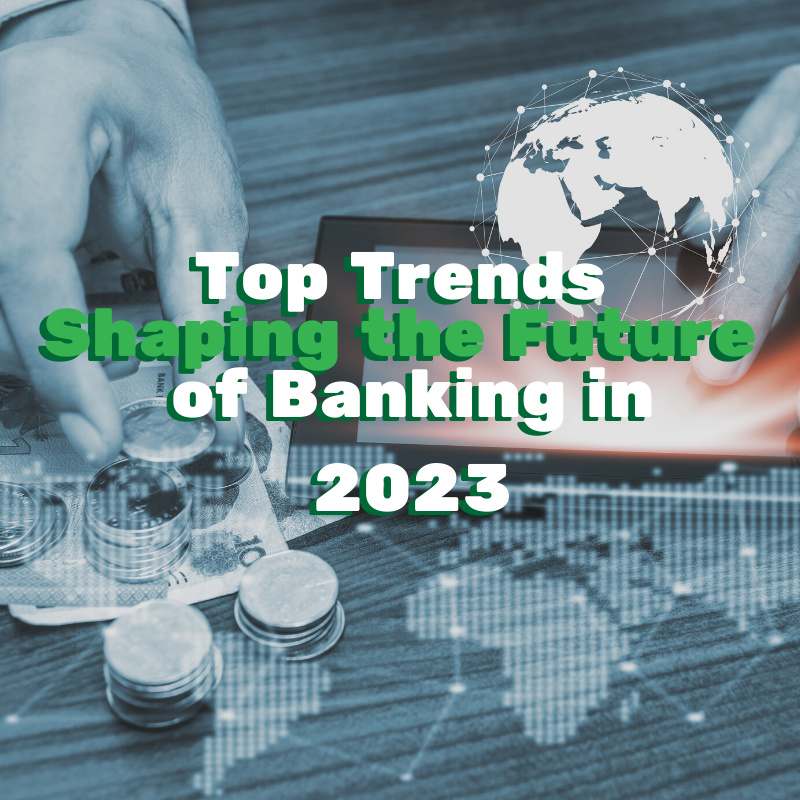Financial
Top Trends Shaping the Future of Banking in 2023.
As technology continues to evolve and disrupt traditional industries, the banking industry is no exception. With the rise of fintech and changing consumer preferences, banks are facing a rapidly changing landscape. In this blog post, we will explore the top 10 trends shaping the future of banking in 2023.
Digital Transformation
As consumers increasingly rely on digital channels for banking services, banks are investing heavily in digital transformation initiatives. This includes developing mobile banking apps, implementing online account opening processes, and incorporating artificial intelligence and machine learning into their operations.
Digital transformation has become a critical aspect of the banking industry, and the adoption of technology has revolutionized the way that financial institutions operate. With the proliferation of technology, digital transformation has become a necessary step for banks to remain competitive and relevant in the market. In this section, we will discuss the positive effects of digital transformation in banking.
Improved Customer Experience
One of the most significant positive effects of digital transformation in banking is the enhanced customer experience. By leveraging digital technologies such as online banking and mobile banking applications, banks can offer their customers a range of services that were previously unavailable. Customers can now perform transactions, check account balances, and transfer funds from the comfort of their homes, saving them time and effort. Furthermore, digital transformation has made it possible for banks to offer personalized services to their customers, such as customized financial plans, which can help to build trust and loyalty.
Increased Efficiency
Digital transformation has also improved the efficiency of banking operations. By automating routine tasks, banks can streamline their operations and reduce the time and cost required to perform them. For example, with the use of chatbots and virtual assistants, banks can handle customer queries and complaints more efficiently, freeing up employees to focus on more complex tasks. Moreover, digital transformation has enabled banks to adopt agile methodologies and implement real-time analytics, enabling them to respond to market trends and customer needs quickly.
Better Risk Management
The adoption of digital transformation has enabled banks to better manage risk. By leveraging data analytics and machine learning, banks can identify and mitigate potential risks before they become problematic. For example, by analyzing transaction data, banks can detect fraudulent activities and take immediate action to prevent them. Furthermore, digital transformation has enabled banks to improve their compliance with regulatory requirements, such as the Anti-Money Laundering (AML) regulations, by automating the process of identifying and reporting suspicious transactions.
Enhanced Innovation
Digital transformation has also fueled innovation in the banking industry. With the use of digital technologies such as blockchain and Artificial Intelligence (AI), banks can offer new and innovative services to their customers. For example, blockchain technology has enabled banks to offer secure and transparent payment systems, while AI has made it possible for banks to offer personalized investment advice to their customers. Moreover, digital transformation has enabled banks to collaborate with Fintech companies and startups, providing them with access to new ideas and technologies that can help to enhance their services.
Improved Data Security
Digital transformation has also improved data security in the banking industry. By adopting robust cybersecurity measures, such as multi-factor authentication and encryption, banks can protect their customers’ data from cyber threats. Moreover, digital transformation has enabled banks to implement real-time monitoring systems, allowing them to detect and respond to potential security breaches quickly.
Open Banking
Open banking refers to the practice of banks sharing customer data with third-party providers. This trend is gaining momentum, as consumers demand greater access to financial products and services from a variety of providers. In 2023, open banking is likely to become even more prevalent, as regulators and industry players work to standardize data-sharing practices.
Personalization
Consumers expect personalized banking experiences that cater to their individual needs and preferences. In response, banks are increasingly using data analytics and AI to offer personalized products and services, such as customized investment portfolios and tailored financial advice.
Blockchain and Cryptocurrencies
Blockchain technology and cryptocurrencies are gaining momentum in the banking industry. In 2023, banks are likely to continue exploring the potential of these technologies to improve transaction processing, reduce costs, and enhance security.
Biometric Authentication
Biometric authentication, such as fingerprint and facial recognition, is becoming increasingly common in the banking industry. These technologies offer greater security and convenience, and are likely to become even more prevalent in 2023.
Platformization
Banks are increasingly adopting platform business models, where they offer a range of products and services from third-party providers through their own platforms. This allows banks to offer a wider range of services to customers, while generating additional revenue streams.
Collaboration with Fintechs
Collaboration with fintech companies is becoming more common in the banking industry, as banks look to leverage the innovation and agility of these startups. In 2023, we are likely to see even more collaboration between banks and fintechs, as they work together to develop new products and services.
Focus on Customer Experience
Customer experience is becoming a key differentiator in the banking industry. Banks are investing in customer-centric initiatives, such as omnichannel banking and personalized services, to improve the customer experience and retain customers.
Cybersecurity
As the banking industry becomes increasingly digital, cybersecurity is becoming more important than ever. Banks are investing heavily in cybersecurity measures to protect their customers’ data and prevent cyber attacks.
Sustainability
Sustainability is becoming a key consideration for banks, as consumers demand greater accountability and social responsibility from financial institutions. In 2023, we are likely to see banks increasing their focus on sustainability, through initiatives such as green financing and reducing their carbon footprint.
Key Takeaways from Gracia
In conclusion, we can say that the banking industry is undergoing a period of rapid transformation, driven by technology, changing consumer preferences, and regulatory developments. By staying abreast of these top 10 trends shaping the industry in 2023, banks can remain competitive and meet the evolving needs of their customers.
MUST READ AND SHARE!
Compilation of Blogs to Get Started with Beginner Stocks
2023 Your Practical Wedding Guide
Investments and Finance Ultimate Guide
Your Ultimate Access to Kuwait Directories in this COVID-19 Crisis
How can you spot a good stock for long term
Stock Investment A Beginner’s Guide
How can you spot a good stock for long term
If you like reading this, please like and share my page, DIARYNIGRACIA PAGE. Questions, or suggestions, send me at diarynigracia@gmail.com
You may also follow my Instagram account featuring microliterature #microlit. For more of my artwork, visit DIARYNIGRACIA INSTAGRAM

A multi-award-winning blogger and advocate for OFWs and investment literacy; recipient of the Mass Media Advocacy Award, Philippine Expat Blog Award, and Most Outstanding Balikbayan Award. Her first book, The Global Filipino Bloggers OFW Edition, was launched at the Philippine Embassy in Kuwait. A certified Registered Financial Planner of the Philippines specializing in the Stock Market. A recognized author of the National Book Development Board of the Philippines. Co-founder of Teachers Specialist Organization in Kuwait (TSOK) and Filipino Bloggers in Kuwait (FBK). An international member of writing and poetry. Published more than 10 books. Read more: About DiaryNiGracia
Acknowledgements
DISCLAIMER



Peace and love to you.